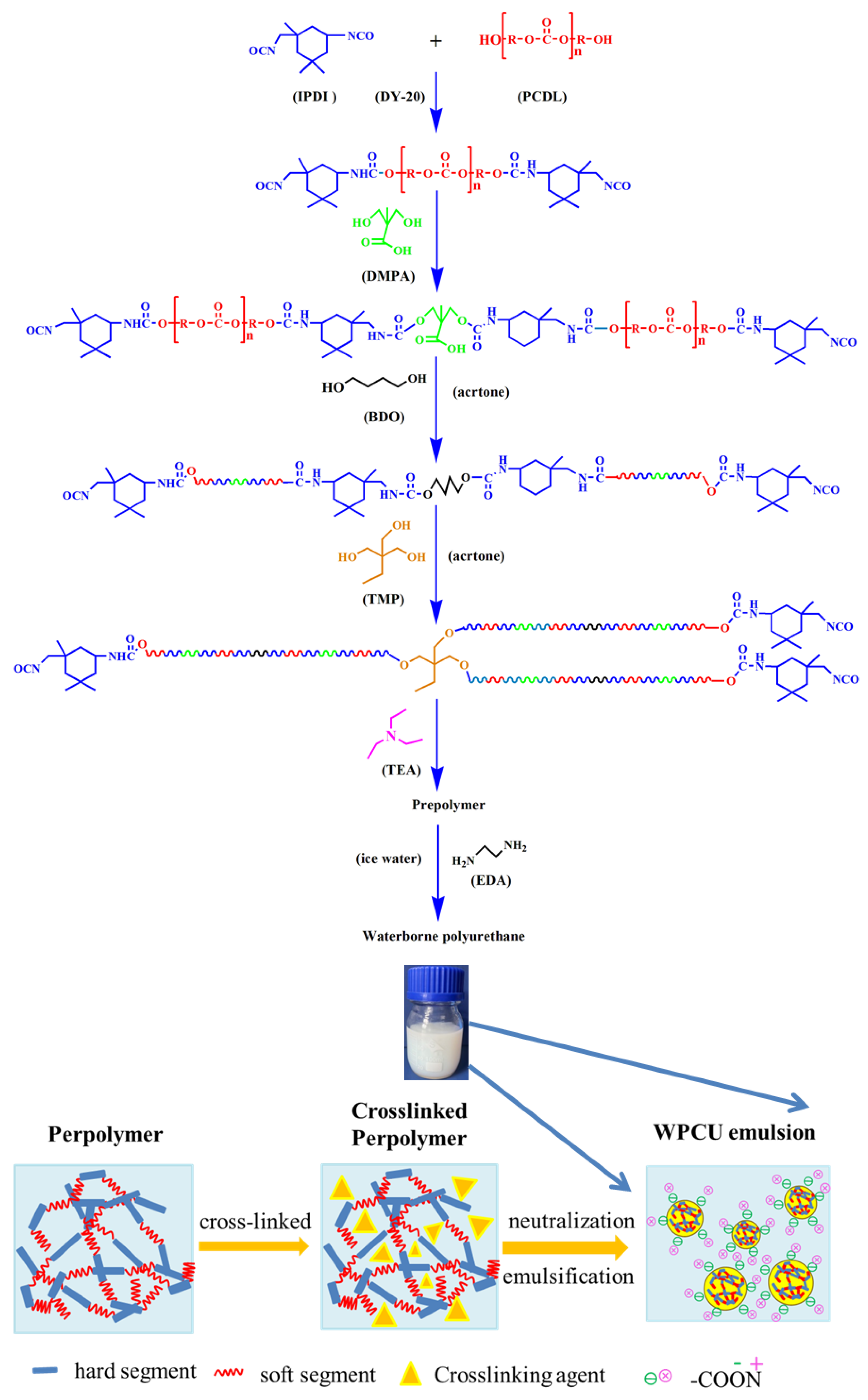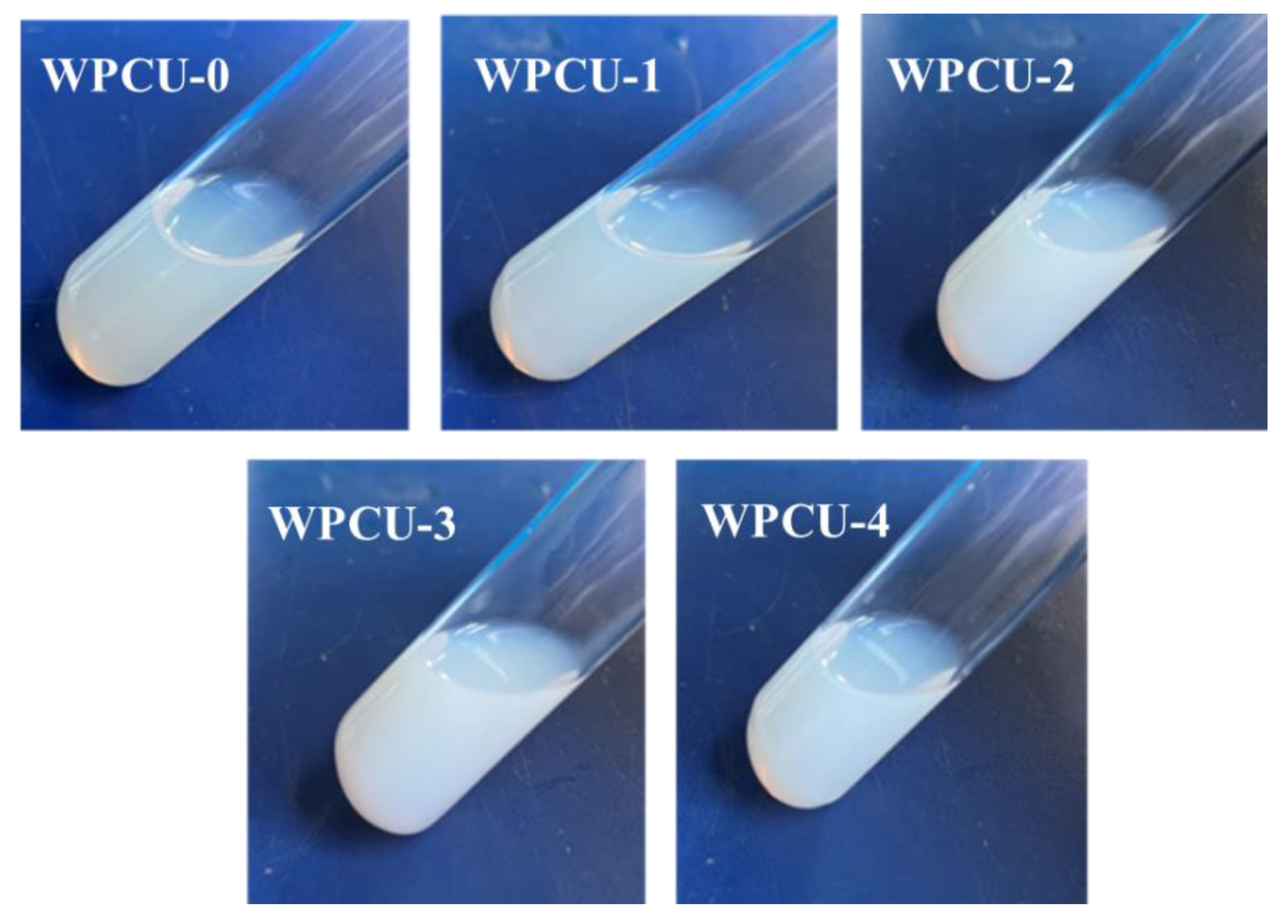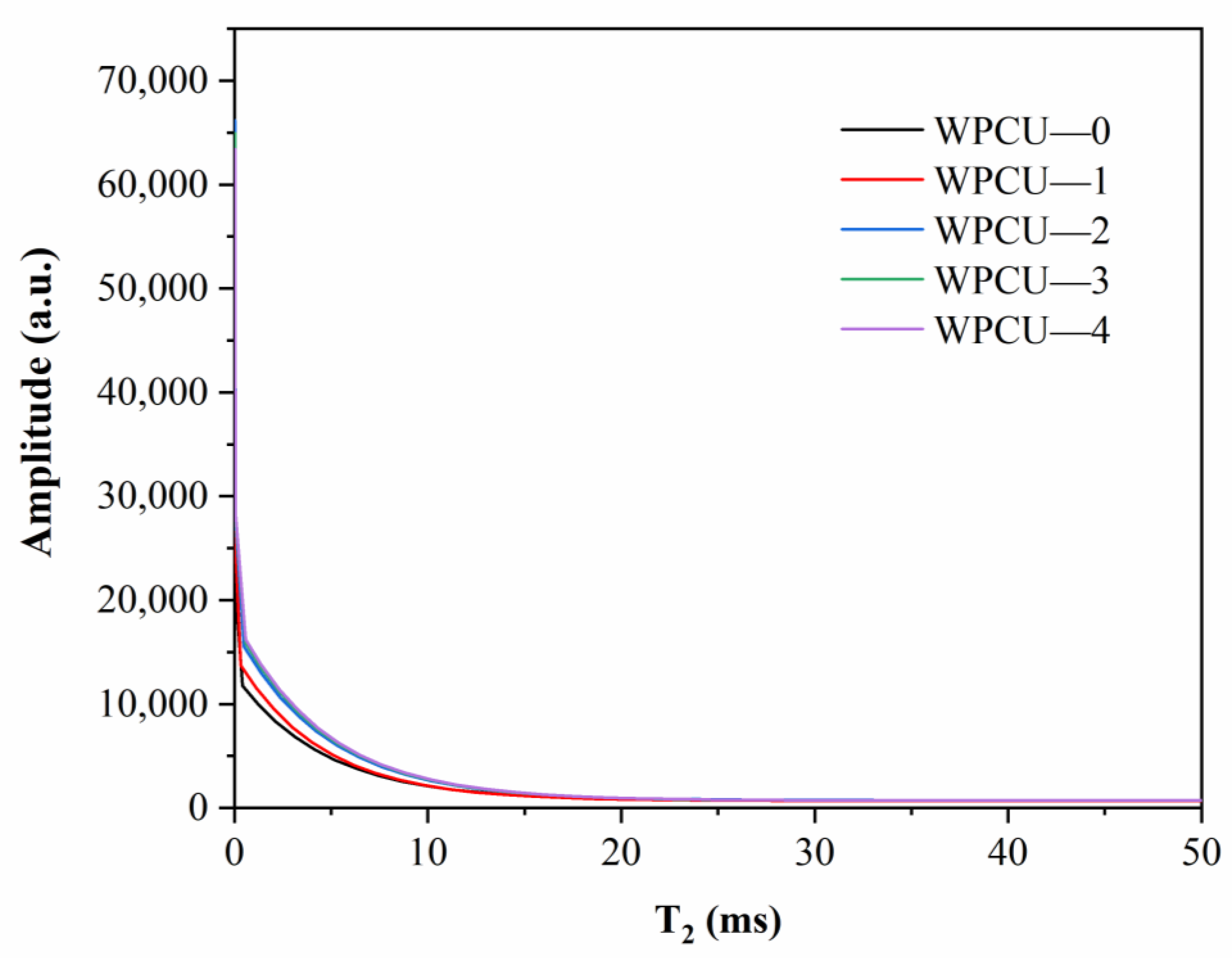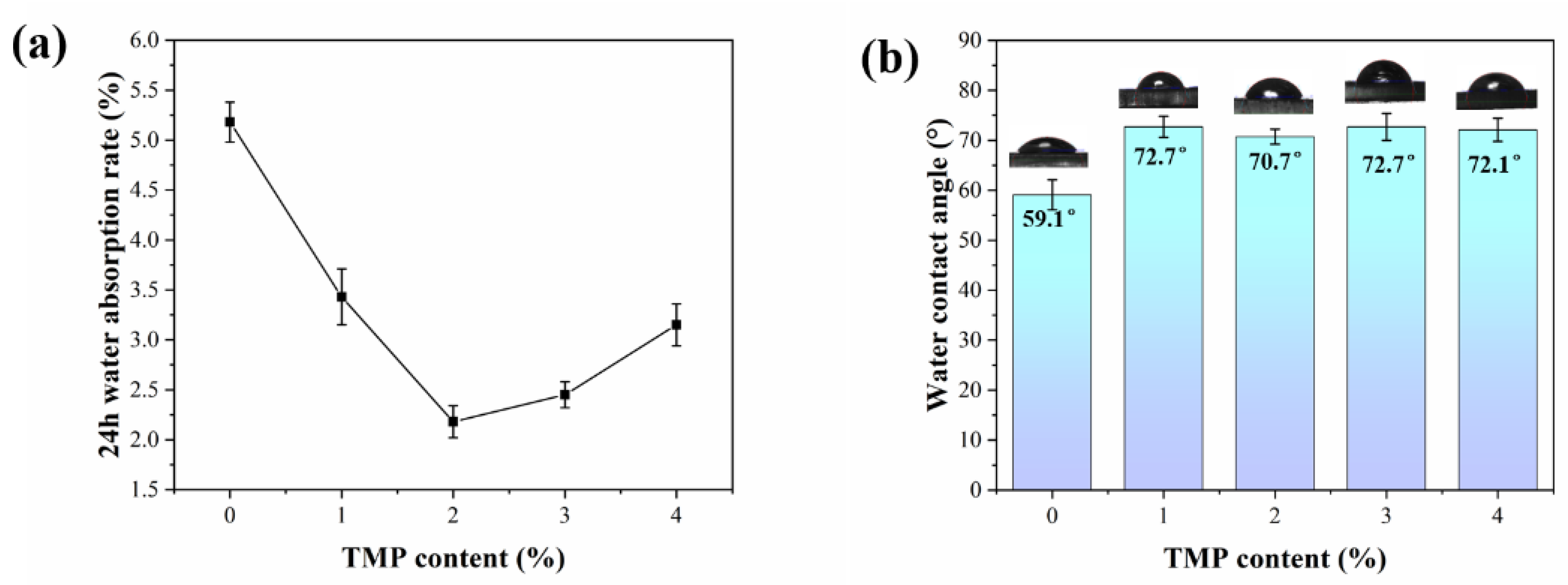Preparation and Properties of a Novel Cross-Linked Network Waterborne Polyurethane for Wood Lacquer
Abstract
1. Introduction
2. Experimental
2.1. Materials
2.2. Preparation of WPCU Emulsions
2.3. Preparation of WPCU Film
2.4. Preparation of WPCU Wood Lacquer
2.5. Coating of Wood Lacquer
2.6. Methods of Characterization
2.6.1. The Characterization of Emulsion
Appearance and Stability Measurement of WPCU Emulsions
Particle Size Analysis
Viscosity Measurement
2.6.2. The Characterization of WPCU Film
Hardness Measurement
Anti-Water and Anti-Alcohol Measurement
Water Absorption Measurement
Structure Characterization
Crosslinking Degree Analysis
Thermal Gravimetric Analysis
Static Contact Angle Analysis
SEM Measurement
Mechanical Performance
2.6.3. The Characterization of Wood Lacquer
3. Results and Discussion
3.1. Characterization of Emulsion
3.1.1. Storage Stability of the Emulsion
3.1.2. Particle Size and Viscosity of the Emulsion
3.2. Characterization of WPCU Film
3.2.1. FTIR Spectroscopy Analyses
3.2.2. NMR Analysis
3.2.3. Water Absorption and Contact Angle Analysis
3.2.4. Anti-Water and Anti-Alcohol Properties of the WPCU Films
3.2.5. SEM Analysis
3.2.6. Thermal Stability Analysis
3.2.7. Mechanical Properties of WPCU Films
3.3. Characterization of Wood Lacquer
4. Conclusions
Author Contributions
Funding
Institutional Review Board Statement
Data Availability Statement
Acknowledgments
Conflicts of Interest
References
- Jia, Y.; Sun, R.; Pan, Y.; Wang, X.; Liu, X. Flexible and thin multifunctional waterborne polyurethane/Ag film for high-efficiency electromagnetic interference shielding, electro-thermal and strain sensing performances. Compos. Part B Eng. 2021, 210, 108668. [Google Scholar] [CrossRef]
- Cui, M.; Li, J.; Qin, D.; Sun, J.; Fan, H. Intumescent flame retardant behavior of triazine group and ammonium polyphosphate in waterborne polyurethane. Polym. Degrad. Stab. 2021, 183, 109439. [Google Scholar] [CrossRef]
- Huang, L.; Lee, W.; Chen, Y. Bio-Based Hydrogel and Aerogel Composites Prepared by Combining Cellulose Solutions and Waterborne Polyurethane. Polymers 2022, 14, 204. [Google Scholar] [CrossRef]
- Qian, Y.; Dong, F.; Guo, L.; Xu, X.; Liu, H. Terpene derivative-containing silicone two-component waterborne polyurethane for coatings. Prog. Org. Coat. 2021, 153, 106137. [Google Scholar] [CrossRef]
- Yang, M.; Li, Y.; Dang, X. An eco-friendly wood adhesive based on waterborne polyurethane grafted with gelatin derived from chromium shavings waste. Environ. Res. 2022, 206, 112266. [Google Scholar] [CrossRef] [PubMed]
- Xu, C.; Ouyang, L.; Cai, Z.; Yan, R.; Shi, W. Effects of polyaminosiloxane on the structure and properties of modified waterborne polyurethane. J. Appl. Polym. Sci. 2018, 136, 47226. [Google Scholar] [CrossRef]
- Liang, Z.; Zhu, J.; Li, F.; Wu, Z.; Liu, Y.; Xiong, D. Synthesis and properties of self-crosslinking waterborne polyurethane with side chain for water-based varnish. Prog. Org. Coat. 2021, 150, 105972. [Google Scholar] [CrossRef]
- Liu, C.; Yin, Q.; Li, X.; Hao, L.; Ma, J. A waterborne polyurethane–based leather finishing agent with excellent room temperature self-healing properties and wear-resistance. Adv. Compos. Hybrid Mater. 2021, 4, 138–149. [Google Scholar] [CrossRef]
- Lyu, J.; Xu, K.; Zhang, N.; Lu, C.; Li, X. In Situ Incorporation of Diamino Silane Group into Waterborne Polyurethane for Enhancing Surface Hydrophobicity of Coating. Molecules 2019, 24, 1667. [Google Scholar] [CrossRef]
- Zhang, W.; Zou, X.; Liu, X.; Liang, Z.; Ge, Z.; Luo, Y. Preparation and properties of waterborne polyurethane modified by aminoethylaminopropyl polydimethylsiloxane for fluorine-free water repellents. Prog. Org. Coat. 2020, 139, 105407. [Google Scholar] [CrossRef]
- Dong, F.; Qian, Y.; Xu, X.; Shaghaleh, H.; Guo, L.; Liu, H.; Wang, S. Preparation and characterization of UV-curable waterborne polyurethane using isobornyl acrylate modified via copolymerization. Polym. Degrad. Stab. 2020, 184, 109474. [Google Scholar] [CrossRef]
- Lei, L.; Zhong, L.; Lin, X.; Li, Y.; Xia, Z. Synthesis and characterization of waterborne polyurethane dispersions with different chain extenders for potential application in waterborne ink. Chem. Eng. J. 2014, 253, 518–525. [Google Scholar] [CrossRef]
- Liu, N.; Zhao, Y.; Kang, M.; Wang, J.; Wang, X.; Feng, Y.; Yin, N.; Li, Q. The effects of the molecular weight and structure of polycarbonatediols on the properties of waterborne polyurethanes. Prog. Org. Coat. 2015, 82, 46–56. [Google Scholar] [CrossRef]
- Liu, Y.; Liang, H.Q.; Li, S.; Liu, D.; Zhu, F.M. Preparation of waterborne polyurethane with high solid content and elasticity. J. Polym. Res. 2019, 26, 146. [Google Scholar] [CrossRef]
- Xu, J.; Li, T.; Zhao, W.; Li, P.; Wu, Y. Synthesis and characterization of waterborne polyurethane emulsions based on poly(butylene itaconate) ester. Des. Monomers Polym. 2016, 19, 309–318. [Google Scholar] [CrossRef]
- Kuran, W.; Sobczak, M.; Listos, T.; Debek, C.; Florjanczyk, Z. New route to oligocarbonate diols suitable for the synthesis of polyurethane elastomers. Polymer 2000, 41, 8531–8541. [Google Scholar] [CrossRef]
- García-Pacios, V.; Colera, M.; Iwata, Y.; Martín-Martínez, J.M. Incidence of the polyol nature in waterborne polyurethane dispersions on their performance as coatings on stainless steel. Prog. Org. Coat. 2013, 76, 1726–1729. [Google Scholar] [CrossRef]
- Wu, G.; Song, X.; Yang, Z.; Li, Y.; Zhang, H. Synthesis and Characterization of Biodegradable Polyester/Polyether WPU as the Environmental Protection Coating. J. Polym. Environ. 2021, 30, 528–540. [Google Scholar] [CrossRef]
- Lee, C.F.; Chen, C.W.; Rwei, S.P.; Chuang, F.S. Thermal Behavior and Morphology of Thermoplastic Polyurethane Derived from Different Chain Extenders of 1,3- and 1,4-Butanediol. Appl. Sci. 2021, 11, 698. [Google Scholar] [CrossRef]
- Liu, B.; Tian, H.; Zhu, L. Structures and properties of polycarbonate modified polyether-polyurethanes prepared by transurethane polycondensation. J. Appl. Polym. Sci. 2015, 132, 42804. [Google Scholar] [CrossRef]
- Lee, D.-K.; Tsai, H.-B.; Tsai, R.-S. Effect of composition on aqueous polyurethane dispersions derived from polycarbonatediols. J. Appl. Polym. Sci. 2006, 102, 4419–4424. [Google Scholar] [CrossRef]
- Lee, D.-K.; Tsai, H.-B.; Tsai, R.-S. Aqueous polyurethane dispersions derived from polycarbonatediols and Di(4-isocyanatocyclohexyl)methane. Polym. Eng. Sci. 2006, 46, 588–593. [Google Scholar] [CrossRef]
- García-Pacios, V.; Jofre-Reche, J.A.; Costa, V.; Colera, M.; Martín-Martínez, J.M. Coatings prepared from waterborne polyurethane dispersions obtained with polycarbonates of 1,6-hexanediol of different molecular weights. Prog. Org. Coat. 2013, 76, 1484–1493. [Google Scholar] [CrossRef]
- Gao, F.; Cao, J.; Wang, Q.; Liu, R.; Zhang, S.; Liu, J.; Liu, X. Properties of UV-cured self-healing coatings prepared with PCDL-based polyurethane containing multiple H-bonds. Prog. Org. Coat. 2017, 113, 160–167. [Google Scholar] [CrossRef]
- Costa, V.; Nohales, A.; Félix, P.; Guillem, C.; Gutiérrez, D.; Gómez, C.M. Structure–property relationships of polycarbonate diol-based polyurethanes as a function of soft segment content and molar mass. J. Appl. Polym. Sci. 2015, 132, 41704. [Google Scholar] [CrossRef]
- García-Pacios, V.; Iwata, Y.; Colera, M.; Miguel Martín-Martínez, J. Influence of the solids content on the properties of waterborne polyurethane dispersions obtained with polycarbonate of hexanediol. Int. J. Adhes. Adhes. 2011, 31, 787–794. [Google Scholar] [CrossRef]
- Hu, L.; Pu, Z.; Zhong, Y.; Liu, L.; Cheng, J.; Zhong, J. Effect of different carboxylic acid group contents on microstructure and properties of waterborne polyurethane dispersions. J. Polym. Res. 2020, 27, 129. [Google Scholar] [CrossRef]
- Wu, Z.; Guo, Q.; Jia, R.P.; Liu, F.W. Structure and Properties of UV-Curable Waterborne Polyurethane/Acrylate Composite Resin. Adv. Mater. Res. 2010, 177, 677–681. [Google Scholar]
- Wang, X.; Fu, Y.; Guo, P.; Ren, L.; Wang, H.; Qiang, T. Synthesis, characterization, and properties of PCDL aliphatic hyperbranched polyurethane coatings. J. Appl. Polym. Sci. 2013, 130, 2671–2679. [Google Scholar] [CrossRef]
- Yang, J.; Gao, Y.; Li, J.; Ding, M.; Chen, F.; Tan, H.; Fu, Q. Synthesis and microphase separated structures of polydimethylsiloxane/polycarbonate-based polyurethanes. RSC Adv. 2013, 3, 8291–8297. [Google Scholar] [CrossRef]
- Fang, H.; Wang, H.; Sun, J.; Wei, H.; Ding, Y. Tailoring elastomeric properties of waterborne polyurethane by incorporation of polymethyl methacrylate with nanostructural heterogeneity. RSC Adv. 2016, 6, 13589–13599. [Google Scholar] [CrossRef]
- Wang, Y.; Chen, R.; Li, T.; Ma, P.; Zhang, H.; Du, M.; Chen, M.; Dong, W. Antimicrobial Waterborne Polyurethanes Based on Quaternary Ammonium Compounds. Ind. Eng. Chem. Res. 2019, 59, 458–463. [Google Scholar] [CrossRef]
- Lai, X.; Li, X.; Wang, L.; Shen, Y. Synthesis and characterizations of waterborne polyurethane modified with 3-aminopropyltriethoxysilane. Polym. Bull. 2010, 65, 45–57. [Google Scholar]
- Cao, X.; Ge, X.; Chen, H.; Li, W. Effects of trimethylol propane and AAS salt on properties of waterborne polyurethane with low gloss. Prog. Org. Coat. 2017, 107, 5–13. [Google Scholar] [CrossRef]
- Che, J.-Y.; Cheon, J.-M.; Chun, J.-H.; Park, C.-C.; Lee, Y.-H.; Kim, H.-D. Preparation and properties of emulsifier-/solvent-free slightly cross-linked waterborne polyurethane-acrylic hybrid emulsions for footwear adhesives (III)–effect of trimethylol propane (TMP)/ethylene diamine (EDA) content. J. Adhes. Sci. Technol. 2017, 31, 1872–1887. [Google Scholar] [CrossRef]
- Zhu, J.; Wu, Z.; Xiong, D.; Pan, L.; Liu, Y. Preparation and properties of a novel low crystallinity cross-linked network waterborne polyurethane for water-based ink. Prog. Org. Coat. 2019, 133, 161–168. [Google Scholar] [CrossRef]
- Wang, X.; Chu, F. Effect of the Polyols Content on the Properties of the Waterborne Polyurethane; Springer: Berlin/Heidelberg, Germany, 2016. [Google Scholar]
- Meng, L.; Shi, X.; Zhang, R.; Yan, L.; Liang, Z.; Nie, Y.; Zhou, Z.; Hao, T. Preparation and properties study of waterborne polyurethane synthesized by mixing polyester diols and isocyanates. J. Appl. Polym. Sci. 2020, 137, 49314. [Google Scholar] [CrossRef]
- Peng, X.; Liu, Y.; Xin, B.; Guo, H.; Yu, Y. Preparation and characterization of waterborne polyurethane nail enamel modified by silane coupling agent. J. Coat. Technol. Res. 2020, 17, 1377–1387. [Google Scholar] [CrossRef]
- Simon, G.; Birnstiel, A.; Schimmel, K.H. Network characterisation of end-linked poly(dimethylsiloxane) by 1 H-NMR-spin-spin relaxation. Polym. Bull. 1989, 21, 235–241. [Google Scholar] [CrossRef]
- Cai, G.; Shi, M.; Gao, J.; Yuan, L. Preparation and photochromic properties of waterborne polyurethane containing spirooxazine groups. J. Appl. Polym. Sci. 2018, 136, 47067. [Google Scholar] [CrossRef]
- Zhang, M.; Song, F.; Wang, X.L.; Wang, Y.Z. Development of soy protein isolate/waterborne polyurethane blend films with improved properties. Colloids Surf. B Biointerfaces 2012, 100, 16–21. [Google Scholar] [CrossRef]
- Zhao, J.; Yang, R.; Iervolino, R.; Barbera, S. Investigation of crosslinking in the thermooxidative aging of nitrile-butadiene rubber. J. Appl. Polym. Sci. 2015, 132, 41319. [Google Scholar] [CrossRef]
- Mohammadi, A.; Barikani, M.; Doctorsafaei, A.H.; Isfahani, A.P.; Shams, E.; Ghalei, B. Aqueous dispersion of polyurethane nanocomposites based on calix [4]arenes modified graphene oxide nanosheets: Preparation, characterization, and anti-corrosion properties. Chem. Eng. J. 2018, 349, 466–480. [Google Scholar] [CrossRef]
- Chai, C.-P.; Ma, Y.-F.; Li, G.-P.; Ge, Z.; Ma, S.-Y.; Luo, Y.-J. The preparation of high solid content waterborne polyurethane by special physical blending. Prog. Org. Coat. 2018, 115, 79–85. [Google Scholar] [CrossRef]
- Hiranobe, C.T.; Ribeiro, G.D.; Torres, G.B.; Reis, E.A.P.d.; Cabrera, F.C.; Job, A.E.; Paim, L.L.; Santos, R.J.D. Cross-Linked Density Determination of Natural Rubber Compounds by Different Analytical Techniques. Mater. Res. 2021, 24, e20210041. [Google Scholar] [CrossRef]
- Zhang, J.; Shang, C.; Yu, Z.; Wang, L.; Tang, J.; Huang, F. Effect of the Crosslinking Degree on Self-Healing Poly(1,2,3-Triazolium) Adhesive. Macromol. Rapid Commun. 2022, 43, e2100236. [Google Scholar] [CrossRef]
- Kopac, T.; Abrami, M.; Grassi, M.; Rucigaj, A.; Krajnc, M. Polysaccharide-based hydrogels crosslink density equation: A rheological and LF-NMR study of polymer-polymer interactions. Carbohydr. Polym. 2022, 277, 118895. [Google Scholar] [CrossRef]
- Li, C.; Li, J.; Cao, T.; Cai, P.; Wang, N.; An, Q.-F. Impact of crosslinking on organic solvent nanofiltration performance in polydimethylsiloxane composite membrane: Probed by in-situ low-field nuclear magnetic resonance spectroscopy. J. Membr. Sci. 2021, 633, 119382. [Google Scholar] [CrossRef]
- Kuhn, W.; Barth, P.; Hafner, S.; Simon, G.; Schneider, H. Material Properties Imaging of Cross-Linked Polymers by NMR. Macromolecules 1994, 27, 5773–5779. [Google Scholar] [CrossRef]
- Miwa, M.; Nakajima, A.; Fujishima, A.; Hashimoto, K.; Watanabe, T. Effects of the Surface Roughness on Sliding Angles of Water Droplets on Superhydrophobic Surfaces. Langmuir 2000, 16, 5754–5760. [Google Scholar] [CrossRef]
- Yoshimitsu, Z.; Nakajima, A.; Watanabe, T.; Hashimoto, K. Effects of Surface Structure on the Hydrophobicity and Sliding Behavior of Water Droplets. Langmuir 2002, 18, 5818–5822. [Google Scholar] [CrossRef]
- Cakic, S.M.; Ristic, I.S.; Krakovsky, I.; Stojiljkovic, D.T.; Bělsky, P.; Kollová, L. Crystallization and thermal properties in waterborne polyurethane elastomers: Influence of mixed soft segment block. Mater. Chem. Phys. 2014, 144, 31–40. [Google Scholar] [CrossRef]
- Dong, X.; Ren, J.; Duan, Y.; Wu, D.; Lin, L.; Shi, J.; Jia, R.; Xu, X.; He, X. Preparation and properties of green UV-curable itaconic acid cross-linked modified waterborne polyurethane coating. J. Appl. Polym. Sci. 2021, 139, e52042. [Google Scholar] [CrossRef]
- Liu, X.; Xie, R.; Chen, T.; He, L.; Chen, M. Improvement of polyurethane film strength by H-bonding cross-linking with hydroxylated melamine. J. Appl. Polym. Sci. 2021, 138, e51411. [Google Scholar] [CrossRef]
- Zhang, A.; Li, J.; Fan, H.; Xiang, J.; Wang, L.; Yan, J. Effect of mechanical properties on the self-healing behavior of waterborne polyurethane coatings. J. Appl. Polym. Sci. 2022, 139, 52364. [Google Scholar] [CrossRef]
- Pamir, O.; Ocal, N.; Aydogan, F. Synthesis, characterization and dispersion stabilities of novel ionic and nonionic diol modified waterborne polyurethane dispersions with different polyols. J. Dispers. Sci. Technol. 2023, 44, 585–593. [Google Scholar] [CrossRef]
- Xu, D.; Liang, G.; Qi, Y.; Gong, R.; Zhang, X.; Zhang, Y.; Liu, B.; Kong, L.; Dong, X.; Li, Y. Enhancing the Mechanical Properties of Waterborne Polyurethane Paint by Graphene Oxide for Wood Products. Polymers 2022, 14, 5456. [Google Scholar] [CrossRef]












| Sample | IPDI (mol) | PCDL (g) | DMPA (mol) | TMP (mol) | BDO (mol) | TEA (mol) | Total mass (g) | Water (g) |
|---|---|---|---|---|---|---|---|---|
| WPCU-0 | 0.079 | 26.11 | 0.013 | 0 | 0.040 | 0.013 | 50.98 | 94.68 |
| WPCU-1 | 0.079 | 26.11 | 0.013 | 0.004 | 0.034 | 0.013 | 50.98 | 94.68 |
| WPCU-2 | 0.079 | 26.11 | 0.013 | 0.008 | 0.027 | 0.013 | 50.98 | 94.68 |
| WPCU-3 | 0.079 | 26.11 | 0.013 | 0.011 | 0.023 | 0.013 | 50.98 | 94.68 |
| WPCU-4 | 0.079 | 26.11 | 0.013 | 0.015 | 0.017 | 0.013 | 50.98 | 94.68 |
| Sample | Appearance | Centrifugal Stability | Stability (Month) |
|---|---|---|---|
| WPCU-0 | Blue translucent | Stable | >6 |
| WPCU-1 | Blue translucent | Stable | >6 |
| WPCU-2 | Milky white with light blue | Stable | >6 |
| WPCU-3 | Milky white with light blue | Stable | >6 |
| WPCU-4 | Milky white with light blue | Stable | >6 |
| Sample | T5wt% (°C) | T10wt% (°C) | Tdmax (°C) |
|---|---|---|---|
| WPCU-0 | 259.51 | 288.97 | 368.40 |
| WPCU-1 | 260.21 | 290.65 | 370.72 |
| WPCU-2 | 266.19 | 291.89 | 373.83 |
| WPCU-3 | 267.75 | 290.05 | 377.34 |
| WPCU-4 | 267.85 | 291.35 | 378.26 |
| Sample | Breaking Strength (MPa) | Breaking Elongation (%) |
|---|---|---|
| WPCU-0 | 14.20 | 759.37 |
| WPCU-1 | 35.54 | 732.67 |
| WPCU-2 | 44.02 | 681.92 |
| WPCU-3 | 34.81 | 651.47 |
| WPCU-4 | 34.89 | 624.79 |
| Sample | Gloss (%) | Adhesion (Level) | Hardness | Resistance to Dry Heat |
|---|---|---|---|---|
| Wood board | 1.5 | / | / | / |
| WPCU-0 | 87.2 | 1 | B | pass through |
| WPCU-1 | 86.8 | 1 | HB | pass through |
| WPCU-2 | 89.4 | 1 | H | pass through |
| WPCU-3 | 91.5 | 1 | H | pass through |
| WPCU-4 | 90.3 | 1 | H | pass through |
Disclaimer/Publisher’s Note: The statements, opinions and data contained in all publications are solely those of the individual author(s) and contributor(s) and not of MDPI and/or the editor(s). MDPI and/or the editor(s) disclaim responsibility for any injury to people or property resulting from any ideas, methods, instructions or products referred to in the content. |
© 2023 by the authors. Licensee MDPI, Basel, Switzerland. This article is an open access article distributed under the terms and conditions of the Creative Commons Attribution (CC BY) license (https://creativecommons.org/licenses/by/4.0/).
Share and Cite
Zhou, Y.; Liu, Y.; Xin, B.; Qin, Y.; Kuang, G. Preparation and Properties of a Novel Cross-Linked Network Waterborne Polyurethane for Wood Lacquer. Polymers 2023, 15, 2193. https://doi.org/10.3390/polym15092193
Zhou Y, Liu Y, Xin B, Qin Y, Kuang G. Preparation and Properties of a Novel Cross-Linked Network Waterborne Polyurethane for Wood Lacquer. Polymers. 2023; 15(9):2193. https://doi.org/10.3390/polym15092193
Chicago/Turabian StyleZhou, Yuanyuan, Yan Liu, Binjie Xin, Ying Qin, and Guankun Kuang. 2023. "Preparation and Properties of a Novel Cross-Linked Network Waterborne Polyurethane for Wood Lacquer" Polymers 15, no. 9: 2193. https://doi.org/10.3390/polym15092193
APA StyleZhou, Y., Liu, Y., Xin, B., Qin, Y., & Kuang, G. (2023). Preparation and Properties of a Novel Cross-Linked Network Waterborne Polyurethane for Wood Lacquer. Polymers, 15(9), 2193. https://doi.org/10.3390/polym15092193





